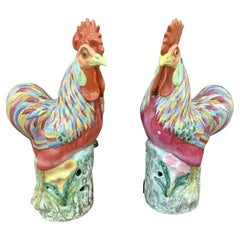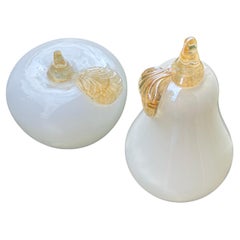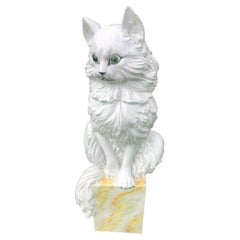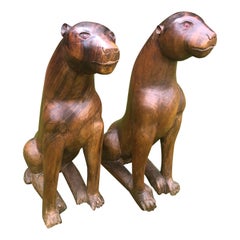Video Loading
Want more images or videos?
Request additional images or videos from the seller
1 of 7
Large Antique Italian Grand Tour Plaster Sculpture of the Dying Gaul
$3,750List Price
About the Item
- Dimensions:Height: 15 in (38.1 cm)Width: 28 in (71.12 cm)Depth: 13.5 in (34.29 cm)
- Style:Grand Tour (Of the Period)
- Materials and Techniques:
- Place of Origin:
- Period:
- Date of Manufacture:1920
- Condition:Wear consistent with age and use.
- Seller Location:Chapel Hill, NC
- Reference Number:1stDibs: LU7371236782021

About the Seller
5.0
Platinum Seller
Premium sellers with a 4.7+ rating and 24-hour response times
Established in 1990
1stDibs seller since 2022
109 sales on 1stDibs
Typical response time: 2 hours
Authenticity Guarantee
In the unlikely event there’s an issue with an item’s authenticity, contact us within 1 year for a full refund. DetailsMoney-Back Guarantee
If your item is not as described, is damaged in transit, or does not arrive, contact us within 7 days for a full refund. Details24-Hour Cancellation
You have a 24-hour grace period in which to reconsider your purchase, with no questions asked.Vetted Professional Sellers
Our world-class sellers must adhere to strict standards for service and quality, maintaining the integrity of our listings.Price-Match Guarantee
If you find that a seller listed the same item for a lower price elsewhere, we’ll match it.Trusted Global Delivery
Our best-in-class carrier network provides specialized shipping options worldwide, including custom delivery.You May Also Like
Large Italian Grand Tour Bronze Sculpture "Dying Galata" /Dying Gaul, C. 1875
Located in West Palm Beach, FL
Large Italian Grand Tour Bronze Sculpture "Dying Galata"/Dying Gaul, C. 1875, Attributed to Naples Foundry
A remarkable large Italian Grand Tour bronze sculpture titled "Dying Galata" or "Dying Gaul," dating circa 1875 and attributed to the renowned Naples Foundry. This exquisite piece, an expertly cast bronze, retains its original black-brown patina and boasts a substantial size, standing 12 inches high, 26.5 inches wide, and 13.5 inches deep. It is a distinguished example of the iconic Grand Tour sculptures, which were popular souvenirs for affluent travelers during the 19th century.
The sculpture is a faithful rendition of the ancient Roman marble statue "The Dying Gaul," also known as "The Dying Galatian" or "The Dying Gladiator." The original marble, now housed in the Capitoline Museums in Rome, is a Roman copy of a lost Greek bronze sculpture...
Category
Antique 19th Century Italian Grand Tour Figurative Sculptures
Materials
Bronze
$7,150
H 12 in W 26.5 in D 13.5 in
Hand Carved Antique Alabaster Sculpture / Statue of The Dying Gaul, Grand Tour
Located in Lisse, NL
Handcarved and remarkable work of art of the 'Dying Gaul’ or 'The Dying Galatian'.
If you are a collector of rare and good quality antiques then this rare and wonderfully hand carve...
Category
Antique Late 19th Century Italian Grand Tour Figurative Sculptures
Materials
Alabaster
$2,888
Free Shipping
H 8.6 in W 17 in D 8 in
Antique Grand Tour Ornately Cast 'The Dying Gaul' Italian Bronze Sculpture
Located in Hamilton, Ontario
This very ornately cast bronze sculpture is unsigned, but presumed to have been done in Italy in approximately 1900, in the Classical Roman style. This figurative study depicts the famous Classical Roman sculpture known as 'The Dying Gaul...
Category
Early 20th Century Italian Classical Roman Figurative Sculptures
Materials
Bronze
$1,295
H 6 in W 10 in D 5 in
Mid-19th Century Grand Tour Bronze Figurative Sculpture 'The Dying Gaul', Italy
Located in North Miami, FL
Mid-19th Century Grand Tour Bronze Figurative Sculpture 'The Dying Gaul', Italy
By: unknown
Material: bronze, copper, metal
Technique: cast, molded, polished, metalwork, patinated
D...
Category
Antique 1850s Italian Grand Tour Figurative Sculptures
Materials
Metal, Bronze, Copper
$5,700
H 14 in W 28 in D 13 in
Grand Tour Neoclassical Bronze of “The Dying Gaul”
Located in Palm Springs, CA
A nice little bronze Grand Tour souvenir bronze of the Dying Gaul a famous sculpture of antiquity preserved in Rome. This bronze has nice detail. The patina is worn in some places and it is in estate found condition. We haven’t tried to clean or polish it.
Some patina loss minor nicks and surfaces scratches, please see the detailed photos.
For this interested this from Wikipedia about the original sculpture:
The Dying Gaul, also called The Dying Galatian[2] (Italian: Galata Morente) or The Dying Gladiator, is an ancient Roman marble semi-recumbent statue now in the Capitoline Museums in Rome. It is a copy of a now lost Greek sculpture from the Hellenistic period (323–31 BC) thought to have been made in bronze.[3] The original may have been commissioned at some time between 230 and 220 BC by Attalus I of Pergamon to celebrate his victory over the Galatians, the Celtic or Gaulish people of parts of Anatolia. The original sculptor is believed to have been Epigonus, a court sculptor of the Attalid dynasty of Pergamon.
Until the 20th century, the marble statue was usually known as The Dying Gladiator, on the assumption that it depicted a wounded gladiator in a Roman amphitheatre.[4] However, in the mid-19th century it was re-identified as a Gaul or Galatian and the present name "Dying Gaul" gradually achieved popular acceptance. The identification as a "barbarian" was evidenced for the figure's neck torc, thick hair and moustache, weapons and shield carved on the floor, and a type of Gallic carnyx between his legs.[5]
Description
The white marble statue, which may originally have been painted, depicts a wounded, slumped Gaulish or Galatian Celt, shown with remarkable realism and pathos, particularly as regards the face. A bleeding sword puncture is visible in his lower right chest. The warrior is represented with characteristic Celtic hairstyle and moustache with a Celtic torc...
Category
Early 20th Century Italian Figurative Sculptures
Materials
Bronze
Grand Tour bronze figure of “The Dying Gaul”, After The Antique
Located in Montreal, QC
A late 19th century Grand Tour bronze figure of “The Dying Gaul”, after the antique. The Dying Gaul depicts a warrior in his final moments, next to his shield and sword, his face contorted in pain just before he collapses from the mortal wound to his chest The original marble figure, which is in the Capitoline museum in Rome is thought to be a Roman copy of a Greek sculpture in Bronze. As an image of a vanquished enemy, the sculpture embodies courage in defeat, self-possession in the face of death, and the recognition of nobility in an alien race.
“The Dying Gaul” was found in Rome with another ancient marble...
Category
Antique Late 19th Century Italian Classical Greek Figurative Sculptures
Materials
Bronze
Grand Tour Plaster Figure Of The Dancing Faun
Located in Lincolnshire, GB
A 19th century Italian plaster figure of the dancing faun, patinated to look like bronze.
Circa 1870
Category
Antique 19th Century Italian Grand Tour Figurative Sculptures
Materials
Plaster
Grand Tour Style Greek Plaster Foot Sculpture
Located in Elkhart, IN
A gorgeous Grand Tour style cast plaster sculpture of an Ancient Greek or Roman foot
Greece, Late 20th Century
Measures: 7.88"W x 3.13"D x 4.5"H.
Very good original vintage ...
Category
Late 20th Century Greek Grand Tour Figurative Sculptures
Materials
Plaster
Antique Italian Grand Tour Sculpture of Lion of Lucerne
Located in Wormelow, Herefordshire
An antique Italian Grand Tour sculpture after the Lion of Lucerne.
Dating to circa 1830, this period model is thought to have been made as a souvenir or a sample of the work by scul...
Category
Antique Early 19th Century Italian Grand Tour Animal Sculptures
Materials
Alabaster
Statuary Marble Sculpture of The Dying Gaul After the Antique
Located in Wormelow, Herefordshire
A mid 19th century statuary marble sculpture of the ‘Dying Gaul’ after the antique.
This marble sculpture is a scale depiction of the larger Dying Gaul marble statue, currently loca...
Category
Antique Mid-19th Century Italian Neoclassical Figurative Sculptures
Materials
Marble, Statuary Marble
$12,076
H 15.16 in W 29.14 in D 13.39 in
More From This Seller
View AllPair of Large Antique Chinese Porcelain Roosters
Located in Chapel Hill, NC
Pair of 1920’s Chinese Porcelain Roosters. Vibrantly painted and decorated in polychrome application. The roosters are shown in their typical...
Category
Early 20th Century Chinese Export Animal Sculptures
Materials
Porcelain
$2,900 / set
Murano White Italian Art Glass Pear and Apple Fruit Sculptures
Located in Chapel Hill, NC
Gorgeous set of Murano handblown white Italian art glass pear and apple sculptures. They are not bookends, but decorative pieces. In the manner of Archimede Seguso. The pear is 7 in...
Category
Mid-20th Century Italian Mid-Century Modern Figurative Sculptures
Materials
Murano Glass
Large Vintage Italian Glazed Terracotta Cat Withe Glass Eyes
Located in Chapel Hill, NC
Regal Vintage Glazed Italian Terracotta Cat in a Seated Pose. This gorgeous cat with beautiful expressive green glass eyes sits atop a glazed marbleized perch. Measuring an impressiv...
Category
Vintage 1940s Italian Mid-Century Modern Animal Sculptures
Materials
Terracotta
Pair of Large Vintage Carved Wooden Panthers
Located in Chapel Hill, NC
Stunning Pair of Life Size Vintage Carved Hardwood Panthers in a seated pose. Each cat is intricately carved with expressive faces and glass eyes. These are Southeastern Asia in orig...
Category
Mid-20th Century Asian Folk Art Animal Sculptures
Materials
Hardwood
$3,900 / set
Pair of Italian Alabaster Sculptural Horse Head Bookends
Located in Chapel Hill, NC
Pair of Italian Alabaster Sculptural Horse Head Bookends. Vibrant turquoise blue horse head figure sit atop a square white alabaster plinth base.
Category
Mid-20th Century Italian Mid-Century Modern Animal Sculptures
Materials
Alabaster
Vintage Italian Marble Orb Paperweight
Located in Chapel Hill, NC
Vintage Italian Marble Orb Paperweight. Round black marble sphere with brown veining atop a turned circular base.
Category
Mid-20th Century Italian Mid-Century Modern Mounted Objects
Materials
Belgian Black Marble
Recently Viewed
View AllMore Ways To Browse
Grand Tour Plaster
Grand Tour Sculpture Plaster
Dying Gaul
The Dying Gaul
Dying Gaul Sculpture
Egyptian Dancer
Goldscheider Terracotta
Lalique Hood Ornament
Marble Sculpture Fragment
Moreau Spelter
Rape Of The Sabine
Sculptures Of Lovers
Terra Cotta Paintings
Tomb Figure
Woman Dancer Sculpture
17th Century Terracotta
18th Century Italian Cherub
A Carrier Bronze



